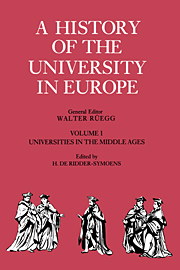Book contents
- Frontmatter
- Contents
- List of maps
- Contributors and editors
- Reader's guide
- Bibliographical abbreviations used in notes
- FOREWORD
- Acknowledgements
- PART I THEMES AND PATTERNS
- CHAPTER 1 THEMES
- CHAPTER 2 PATTERNS
- PART II STRUCTURES
- PART III STUDENTS
- PART IV LEARNING
- THE FACULTY OF ARTS
- EPILOGUE
- Editors' note on the indexes
- Name index
- Geographical and subject index
CHAPTER 2 - PATTERNS
- Frontmatter
- Contents
- List of maps
- Contributors and editors
- Reader's guide
- Bibliographical abbreviations used in notes
- FOREWORD
- Acknowledgements
- PART I THEMES AND PATTERNS
- CHAPTER 1 THEMES
- CHAPTER 2 PATTERNS
- PART II STRUCTURES
- PART III STUDENTS
- PART IV LEARNING
- THE FACULTY OF ARTS
- EPILOGUE
- Editors' note on the indexes
- Name index
- Geographical and subject index
Summary
No one today would dispute the fact that universities, in the sense in which the term is now generally understood, were a creation of the Middle Ages, appearing for the first time between the twelfth and thirteenth centuries. It is no doubt true that other civilizations, prior to, or wholly alien to, the medieval West, such as the Roman Empire, Byzantium, Islam, or China, were familiar with forms of higher education which a number of historians, for the sake of convenience, have sometimes described as universities. Yet a closer look makes it plain that the institutional reality was altogether different and, no matter what has been said on the subject, there is no real link such as would justify us in associating them with medieval universities in the West. Until there is definite proof to the contrary, these latter must be regarded as the sole source of the model which gradually spread through the whole of Europe and then to the whole world. We are therefore concerned with what is indisputably an original institution, which can only be defined in terms of a historical analysis of its emergence and its mode of operation in concrete circumstances.
The university as studium generale
This problem of definition naturally arose in the Middle Ages also. A term, studium generate, was therefore coined, together with a number of juridical criteria. A studium generate was an institution of higher education founded on, or, at any rate, confirmed in its status by, an authority of a universal nature, such as the pope or (less frequently) the emperor, whose members enjoyed a certain number of rights, likewise universal in their application, which transcended all local divisions (such as towns, dioceses, principalities, and states).
- Type
- Chapter
- Information
- A History of the University in Europe , pp. 35 - 74Publisher: Cambridge University PressPrint publication year: 1991
- 9
- Cited by



